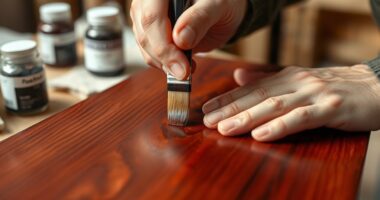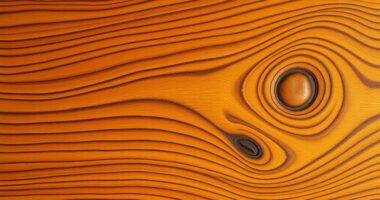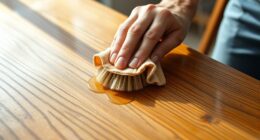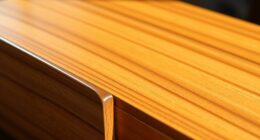If you want durable, attractive finishes, consider polyurethane for high-use furniture and floors, providing strong protection against scratches and spills. Lacquer offers quick-drying, glossy films ideal for cabinetry and artistic projects. Shellac is great for vintage furniture and musical instruments, giving a warm glow while preserving authenticity. Wax finishes enhance natural beauty and are easy to maintain for restoration. Exploring these options further can help you choose the perfect finish for your project’s needs.
Key Takeaways
- Polyurethane provides durable, protective coatings ideal for floors, furniture, and high-use surfaces, available in various sheens and UV-protected options.
- Lacquer offers quick-drying, transparent finishes with customizable sheen levels, perfect for high-traffic furniture and vibrant color applications.
- Shellac enhances vintage furniture and musical instruments with a warm glow, quick drying, and natural breathability, preserving authenticity.
- Wax finishes create a soft, low-luster protective layer that enhances wood grain, ideal for restoration and maintaining a natural look.
- Proper application techniques—such as brushing, spraying, or wiping—along with surface prep and multiple coats, ensure smooth, even, and professional wood finishes.
Polyurethane and Its Uses in Home Furniture and Floors
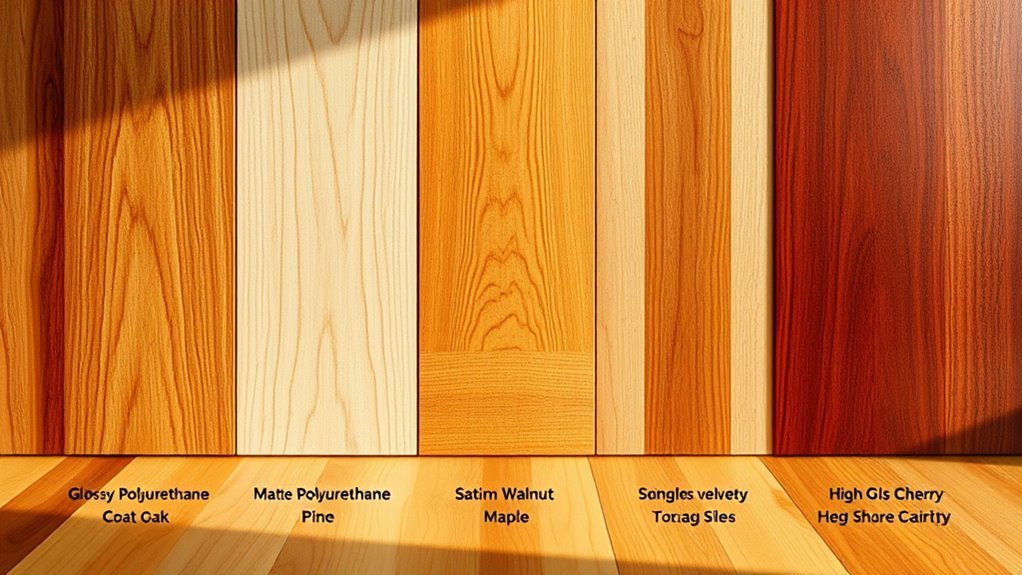
Polyurethane is a popular wood finish that offers durability and versatility for your home furniture and floors. It creates a tough protective barrier against scratches, spills, and daily wear, making it perfect for high-use pieces.
Polyurethane provides a durable, protective finish ideal for furniture and floors.
You can choose from different sheens like satin, semi-gloss, and flat to match your style. For furniture, polyurethane enhances the wood’s appearance, adding a rich, glossy finish that highlights the grain.
When applying, use a brush, foam, or rag, and follow the wood grain for a smooth coat. Multiple coats provide better protection.
For floors, polyurethane withstands heavy foot traffic, protects against damage, and maintains the natural beauty of the wood. UV-protected versions also work outdoors, ensuring your surfaces stay beautiful longer.
Lacquer’s Role in High-End Cabinetry and Artistic Projects

Lacquer plays a crucial role in achieving a high-end finish for cabinetry and artistic projects thanks to its quick-drying properties and ability to form a durable, transparent film. Its fast-drying nature allows you to layer multiple coats in a single day, speeding up your workflow.
The hard, non-yellowing film preserves clarity over time, showcasing intricate wood grain and fine details. With gloss, satin, and matte options, you can customize the sheen to suit your design.
Lacquer’s water resistance and wearability make it ideal for high-traffic surfaces and display pieces. Its compatibility with alcohol-based dyes enables vibrant colors, while its smooth spray application minimizes brush marks and imperfections.
Shellac for Vintage Furniture and Musical Instruments
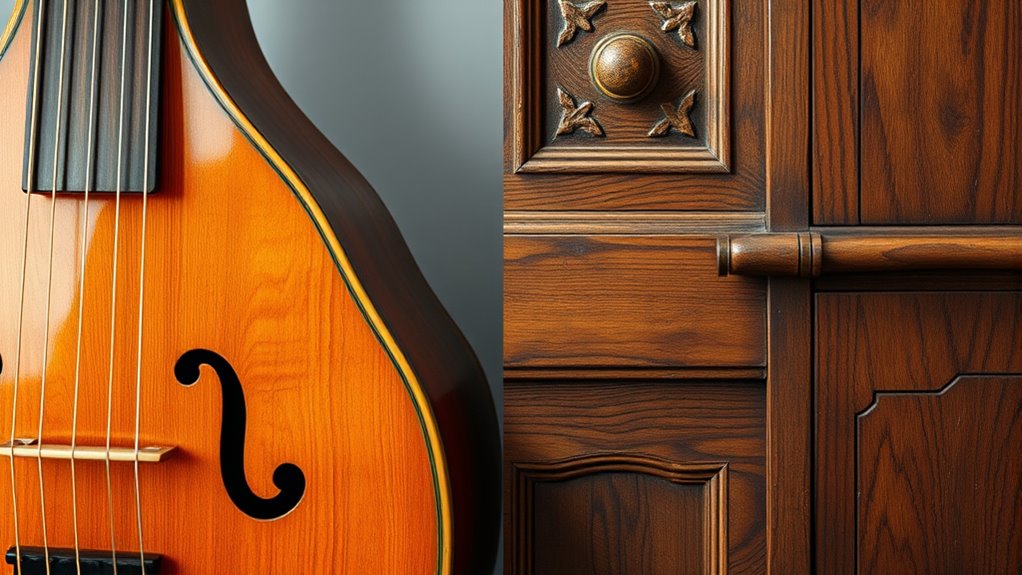
Shellac offers a natural and versatile alternative to synthetic finishes like lacquer, making it particularly popular for restoring vintage furniture and finishing musical instruments. Derived from the Lac bug in India and Thailand, it’s harvested as flakes dissolved in alcohol, resulting in a clear or amber-toned finish. Shellac’s quick drying time and ease of application with brushes, rags, or sprayers allow for efficient work and smooth layering, especially in French polishing. It enhances wood grain with a warm, rich glow, providing a matte finish that feels soft and natural. Its natural, breathable properties make it ideal for preserving the authenticity and tonal qualities of vintage furniture and musical instruments while offering easy touch-ups and restoration. Additionally, shellac’s compatibility with various woods makes it a preferred choice for many woodworking projects requiring a delicate, natural finish. Its resistance to moisture adds to its suitability for items that may encounter varying environmental conditions.
Wax Finishes for Restoration and Maintenance of Wooden Items
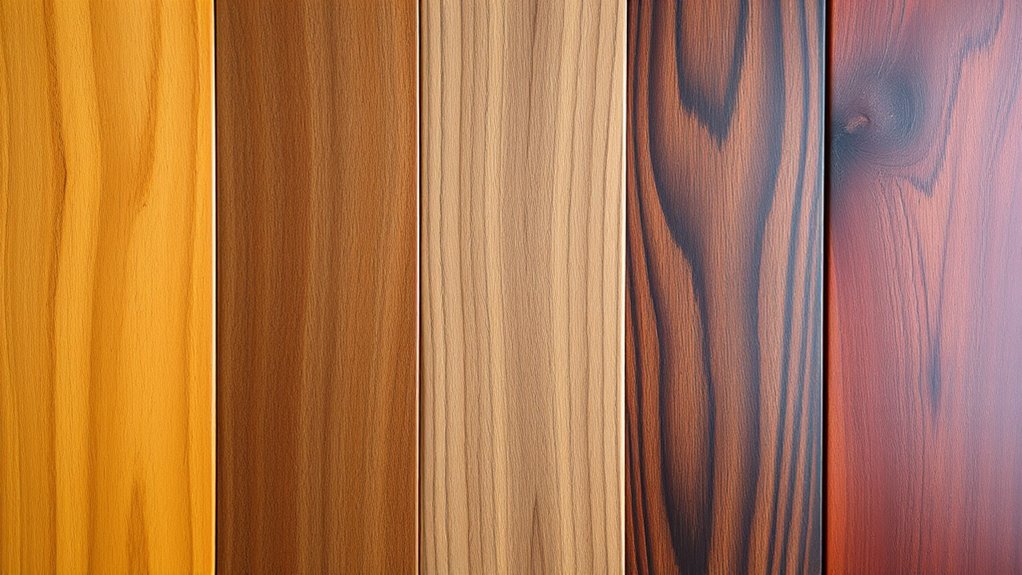
Have you ever noticed how a well-applied wax finish can subtly enhance the beauty of wooden items while providing essential protection? Wax creates a protective layer that guards against moisture and wear, helping your wood resist damage over time. It enhances the natural grain and depth, giving your furniture or decor a soft, low-luster sheen preferred for antiques and delicate pieces. Applying wax is straightforward—you simply clean the surface, then use a cloth or soft brush to apply thin layers, rubbing in the direction of the grain. After it dries, buffing with a soft cloth brings out a smooth, polished look. Wax also fills minor scratches and dull areas, restoring the item’s appearance without harsh chemicals. Regular maintenance with self-watering plant pots can help keep your wooden items in pristine condition for years to come. Additionally, understanding wood finishes can further optimize your restoration efforts and longevity. Using the right glyceric acid in your skincare routine can also help maintain the smooth, polished appearance of your wooden pieces by preventing damage and preserving their finish over time. Incorporating knowledge of preservation efforts can guide you in maintaining the integrity and charm of your wooden treasures.
Various Techniques for Achieving Beautiful Wood Finishes

Achieving a beautiful wood finish depends heavily on choosing the right application techniques. You can use brushes for thicker coats, but be careful to avoid sagging or drips.
Spraying with a spray gun creates smooth, thin coats, ideal for professional results, while aerosol cans offer quick convenience. Using Vetted brands known for quality tools can further enhance the application process.
Wiped-on finishes with a cloth give thin, fast-drying layers with minimal drips.
Before applying any finish, use a tack cloth to remove dust and guarantee smoothness.
Proper preparation includes sanding with 120 to 220 grit, always sanding with the grain, and inspecting the surface with light or paint thinner.
Applying multiple thin coats, controlling drying conditions, and paying attention to edges help achieve an even, stunning finish.
Using proper surface preparation techniques can significantly improve the final appearance and durability of the wood finish.
Additionally, understanding wood grain orientation ensures the finish follows the natural lines of the wood, enhancing its visual appeal.
Being mindful of climate conditions during application can also influence how the finish cures and looks once complete.
These techniques ensure your project looks polished and professional.
Frequently Asked Questions
Which Finish Is Most Eco-Friendly and Non-Toxic?
You’re asking which finish is most eco-friendly and non-toxic. Natural oil-based finishes like tung oil, hemp oil, and other plant-derived oils top the list because they contain no VOCs, no additives, and cure by oxidation, not evaporation.
Beeswax combined with natural oils also offers a safe, environmentally friendly option.
Water-based finishes are another good choice, as they emit fewer VOCs, dry quickly, and are easy to clean up, making them highly eco-conscious.
How Do I Choose the Best Finish for Outdoor Furniture?
Choosing the best finish is like selecting a shield for your outdoor furniture’s soul. You should consider your climate—humidity, sun, rain—and pick a finish that acts as armor, like epoxy or marine varnish, for maximum protection.
Think about appearance—gloss or matte—and budget. Match the finish to your wood type for longevity. With the right choice, your furniture will stand resilient, reflecting your care and love for outdoor living.
Can These Finishes Be Applied Over Stained Wood?
Yes, you can apply these finishes over stained wood. Just make certain proper surface prep by lightly sanding with fine-grit sandpaper and removing dust.
Water-based polyurethane offers a clear, natural look, while oil-based adds warmth.
Gel stains can also be applied over finished surfaces, but wait 72 hours before topcoating.
Always test on a small area first to check adhesion and final appearance.
What Is the Best Finish for Enhancing Wood Grain Visibility?
When it comes to showcasing wood’s natural beauty, you’re really pulling out all the stops. To enhance grain visibility, opt for clear oils or varnishes that highlight delicate details.
Use grain enhancers to boost contrast and apply thin, even coats for depth. Proper surface prep, like fine sanding and filling pores, makes a big difference.
This approach guarantees your wood’s character shines through, giving it a rich, vibrant look that truly stands out.
How Long Does Each Finish Typically Last Before Reapplication?
You’re wondering how often you should reapply wood finishes. Varnish lasts about 10 years, and polyurethane needs reapplication every 5 to 10 years. Wax requires reapplication every few months, while water-based polyurethane lasts around 5 to 8 years.
Oil-based polyurethane can last over 10 years but may need reapplication every 10 to 15 years. Regular maintenance guarantees your wood stays protected and looks great.
Conclusion
Now that you know these top 5 wood finishes, you’re practically a woodworking wizard! Whether you’re transforming a humble piece into a masterpiece or restoring antiques to their former glory, these finishes are your secret weapons. Imagine turning any wooden item into a showstopper so stunning, it’ll stop people in their tracks! Get creative, experiment boldly, and watch your woodworking projects become legendary. The power to craft breathtaking woodwork is in your hands—don’t hold back!


